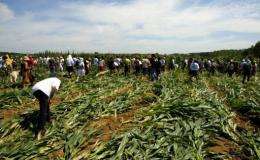10% more GM crops in the world in 2010: study

The amount of the world's farmland given over to genetically modified (GM) crops grew 10% last year, with the United States remaining the biggest zone for the altered produce, according to a study released in Brazil Tuesday.
A total of 148 million hectares (366 million acres) are now given over to GM plantations in 29 countries, handled by 15 million farmers, according to the report by the International Service for the Acquisition of Agri-biotech Applications (ISAAA).
The United States accounts for nearly half that area, 67 million hectares, growing modified soya, maiz, cotton, rapeseed, squash, papaya, alfafa and beetroot.
Brazil was the second-biggest GM producer with 25 million hectares, much of it growing soya, maiz and cotton.
Anderson Galvao, representing the ISAAA in Brazil, said the Latin American nation was taking on GM crops so rapidly that it has doubled grain production in the past two decades.
Defenders of GM crops stress that they are more resistant to disease and insects, and are more productive.
Detractors fear the new varieties will supplant non-GM vegetation, with unknown long-term consequences for the food chain and environment.
(c) 2011 AFP

















